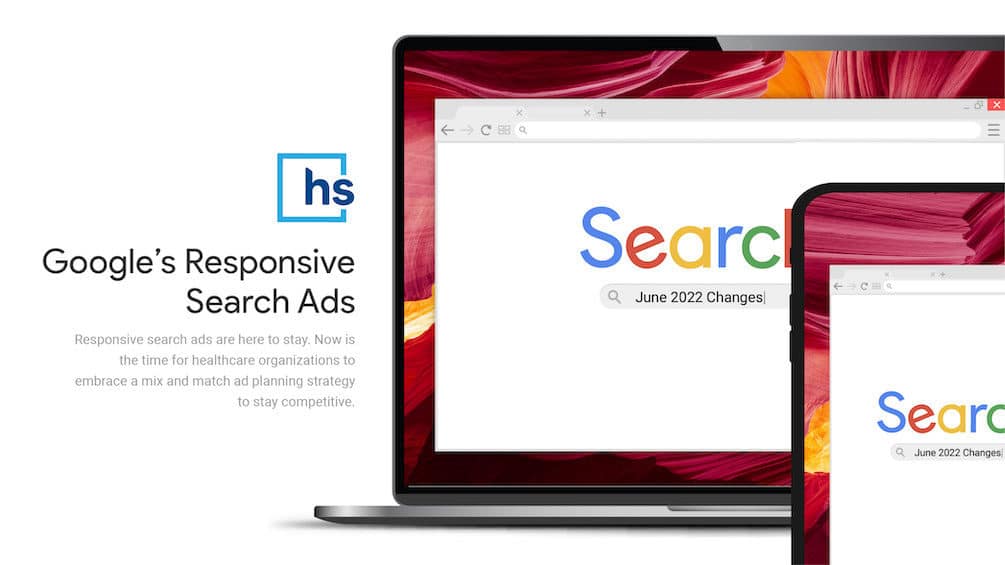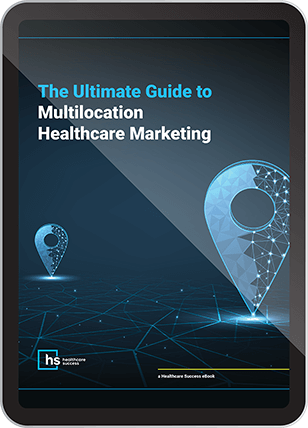Google’s Responsive Search Ad Changes: What You Need to Know
Google Ads are about to change more than they have in years—are you ready?
The days of creating a set of stand-alone ads, setting your daily advertising budget, and periodically checking your analytics are long gone. Even as I write this, the very idea seems archaic, and I suppose it is when you consider how far technology has come in just the last few years.
Today, automation and machine learning dominate all business operations, and online advertising is no different. Healthcare organizations need to embrace these new technologies to stay competitive.
In March 2021, Google Ads replaced expanded text ads (ETAs) with responsive search ads (RSAs) as the default ad type for search campaigns—another step toward automating ad creation, management, and optimization for its clients.
Starting June 30, 2022, RSAs will take an even bigger seat at the Google Ads table while ETAs get further deprioritized.
As consumer trends continue to shift and evolve at a neck-breaking pace, it’s more important than ever to make it easier for people to connect with your healthcare organization through targeted, relevant ads.
In today’s blog post, I share
- Information about the upcoming ETA and RSA changes,
- what these changes mean for healthcare advertisers,
- three advantages of RSAs,
- and how to prepare for the transition.
Let’s get started.
Responsive Search Ads Are the New Default Ad Type in Google Ads
Beginning June 30, 2022, advertisers will no longer have access to create or modify ETAs as Google prioritizes responsive search ads.
The good news is existing ads will remain intact and continue serving alongside RSAs. This means advertisers will also have access to their performance metrics until further notice. When this change takes place, advertisers will only have access to the following ETA functions:
- Pause
- Reactivate
- Remove
What about editing existing ETA campaigns? Edits to ads are considered deletions with new ad creations in Google Ads, so the ability to edit existing ETAs after June 30th is doubtful.
What does this change mean for healthcare advertisers?
RSAs offer a level of automation unavailable with any other ad type, helping healthcare organizations keep up with Google’s rapidly changing technologies and stay competitive.
As you know, automation is a critical element of saving businesses time and money. It has also become the norm.
Embracing RSAs, and the automation that comes with them, allows your business to show up at the top of search engine results pages (SERPs) at the right time and in front of the right people.
Using RSAs, your business can significantly improve campaign performance and ROI as soon as the campaign is live.
Why is Google Making the Change? Advantages of Responsive Search Ads
Google is compelling advertisers to transition to responsive search ads. Why?
It aligns with a general industry-wide shift toward automation and machine learning, which offer several benefits, including:
- Better insights
- Faster processing time
- Increased flexibility and scalability
- Improved quality control
- Increased savings and productivity
According to Google internal data, advertisers that switch from expanded text ads to responsive search ads—using the same assets (e.g., headlines, descriptions, images, and logos)—see an average of 7% more conversions.
The goal of transitioning to RSAs from ETAs is to ensure your consumers see an optimal message every time. Machine learning and automation allow Google Ads to continually test different headline and description combinations to present the most effective ad for each specific search query.
The words and phrases people use to search are constantly evolving. Google says 15% of daily search queries are new. As digital consumer trends change more rapidly than ever, it’s important to create relevant, valuable ads in line with search intent.
RSAs allow advertisers to create up to 15 headlines and four description lines as opposed to the three headlines and two description lines allotted for expanded text ads. I strongly recommend creating as many headlines and descriptions as possible to give Google plenty of combinations to test.
Everything You Need to Know about Responsive Search Ads
ETAs always appear on SERPs precisely as written. With RSAs, however, advertisers create a list of possible headlines and descriptions that Google uses to create ad variations.
These variations allow Google to automatically test assets, sizes, formats, and placements to determine which combinations are the most relevant to the user’s search intent.
As certain ad combos become more relevant, they’ll appear more often, giving your business access to a larger, more engaged audience, which boosts conversions.
Responsive search ads can:
- Accommodate up to 15 headlines, four descriptions, and a display URL
- Appear with any ad extension (additional information about your business appended to the main body of your text ad), potentially leading to a higher presence on the SERP
- Streamline the creation management of search ads
- Lead to better ad performance
- Automatically adapt to different screen sizes
The downside of RSAs is that businesses cannot see the final ad copy before it’s served in the SERP, which may not be the best fit for highly specific campaign structures. Instead of aligning one headline with one description, RSA campaigns mix and match from a pool of 15 headlines and four descriptions.
The good news is Google Ads gives businesses the option to select and pin (more on this later) particular settings which dictate how Google tests your ads.
Three Advantages of RSAs
In addition to giving businesses the ability to reach a wider audience, responsive search ads also:
1. Improve ad performance
As Google continues making updates in favor of automation, healthcare organizations may hesitate. But I encourage you to embrace machine learning and automation to optimize your ad campaigns, generate more clicks, and boost conversions. According to Google, advertisers that add RSAs into their ad groups achieve up to 10% more clicks and conversions. Transitioning to RSAs will require changing your PPC strategy and ad content and improving your overall ad performance.
In a recent study that analyzed 5,606 accounts, RSAs beat ETAs on the main Google Ads metrics in every category including, click-through rate (CTR), conversion rate, return on ad spend (ROAS), cost per click (CPC), and cost per conversion.
2. Adapt more readily to changing consumer behaviors
Consumer needs and priorities are constantly changing. RSAs give advertisers a more efficient way to quickly adapt and eliminate the tedious work of creating, testing, and optimizing several individual static ads.
3. Streamline optimization and account management
RSAs give Google significantly more data to work with, allowing it to make more informed recommendations about ad performance and effectively streamline the account management experience.
In the past, it was considered a best practice to include three ETAs and one RSA per ad group. This meant each ad group would have a minimum of 26 headlines and ten descriptions. As you can probably guess, this also meant advertisers were spending excessive time writing and minimal time optimizing.
By contrast, focusing on RSAs means less time writing and more time improving, saving businesses both time and money.
Responsive Search Ads Vs. Text Ads
While there are pros and cons to each ad type, there’s no denying that Google is driving the future of text ads toward highly automated processes.
Here’s an overview of the pros and cons between responsive search ads vs. text ads:
PROS
RSAs |
ETAs |
|
|
|
|
| |
|
CONS
RSAs |
ETAs |
|
|
|
As the above pros and cons illustrate, RSAs are not a magic wand for ad optimization. Starting in June, paid search success will be defined by how effectively healthcare organizations combine automated processes with manual optimization efforts.
How to Prepare for the Transition
As ETAs get further deprioritized in June, there will be some growing pains unless you plan ahead. Now is the perfect time to get used to responsive search ads vs. text ads in your PPC campaigns. You can help ease the transition to RSAs with these tips:
1. Get comfortable with RSAs now
Start including at least one RSA into each ad group to get comfortable with the process. This will also help you avoid unintended copy variations. Keeping ad campaigns general until you get more comfortable with the process is key to success.
2. Develop and test ETAs
Develop and test several ETAs to find top-performing headlines and descriptions while you still can. When developing your RSAs, you can use these variations, giving your business a competitive edge.
3. Test pinning headlines (when necessary)
Pinning a headline ensures it will only appear in a specified position, giving advertisers the ability to show ads tailored to user intent.
a. Pinning zero assets
This allows all assets to rotate freely into an optimally performing ad (recommended).
b. Pinning two or more assets to one position
This means all ads will contain one of the pinned assets, giving advertisers some control while still allowing the algorithm to determine the best asset combination.
c. Pinning one asset to a position
This means all ads will contain the asset in the position specified (not recommended).
4. Reuse top-performing content
If your business has existing ETA campaigns, take time to identify top-performing keywords and descriptions and reuse them in RSAs. This will help increase ad strength and improve ad relevance, thus improving your overall CTR and quality score (how well your ads are performing compared to other advertisers).
5. Maximize character counts
RSAs have a 30 character limit per headline and 90 character limit per description. Maximize these character counts as much as possible, and be sure to include clear CTAs.
6. Make ETA content evergreen
At the moment, ETAs are not going away completely. Before Google removes editing capabilities, review your entire account to ensure ETAs include optimized evergreen content so they can run for as long as possible.
7. Keep call-only ads
Call-only ads encourage mobile users to contact your business right away. When a potential customer clicks your ad, it automatically calls from their device. Phone calls often generate higher quality leads, more revenue, and higher conversions than digital-based leads, so if you’ve got one in place, keep it—and if you don’t, create one as an ETA and let it run.
8. Leverage Google’s tools
a. Ad strength
The ad strength tool analyzes ad relevance, quantity, and diversity of ad copy, provides a quality score (poor to excellent), and provides recommendations. Ads with ‘Excellent’ ad strength scores see an average of 9% more clicks and conversions than ads with ‘Poor’ ad strength scores.
b. Location insertion
Increase the local relevancy of your ads by inserting a small piece of code in your headline (e.g., “We serve {LOCATION(City)},” targeting unique cities and towns without creating a separate ad for each.
c. Countdown customizer (when applicable)
Increase urgency and encourage more people to click on your ad by incorporating time-sensitive offers.
d. Broad match
Maximize your reach and trigger specific ads when someone searches for a specific keyword, keyword phrase, similar phrases, close variations of the keyword terms or phrases, related searches, and other relevant variations.
e. Cross-campaign asset reporting
Cross-campaign asset reporting provides campaign-level performance and insights, allowing you to identify which assets resonate best with your audience and which assets need to be replaced.
Responsive search ads are here to stay, and ETAs will have fewer functionalities beginning in June. Now is the time for healthcare organizations to embrace a mix and match ad planning strategy to stay competitive in their marketplace.









